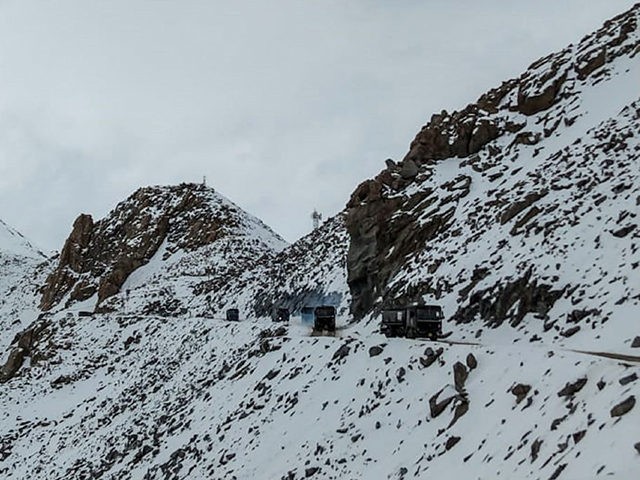The Chinese People’s Liberation Army (PLA) has installed loudspeakers broadcasting anti-Indian government propaganda and, bizarrely, fast-paced Punjabi music on China’s border with India, the Hindustan Times alleged on Thursday.
The music, the newspaper posited, was meant as a distraction for Indian soldiers — an attempt to get them “jiving” and not sufficiently protect their positions. The propaganda, it added, accused Indian civilian officials of forcing soldiers into onerous operations without sufficient reverence for their positions, potentially attempting to get them to defect.
China and India have experienced heightened tensions along their mutual border, spanning the difficult Himalayan terrain of occupied Tibet and northeast India’s Ladakh region, this summer after an incident that left as many as 50 dead. A brawl with rudimentary weapons in the Galwan Valley, Ladakh, in June resulted in 20 deaths and, Indian officials say, twice as many Chinese troops killed. The Chinese Communist Party (CCP) has rejected that death toll but refused to offer any contravening information.
Since June, both sides have reportedly expanded their presence on the border, adding troops, weaponry, and surveillance technology. This month, India and China confirmed that troops fired shots for the first time in 45 years. Indian officials admitted troops fired “warning shots,” but claimed the PLA did the same, which China denied.
Since the Galwan Valley incident, Indian troops have occupied a mountaintop over Pangong Tso, a lake on the border between Ladakh and Tibet. The Hindustan Times reported on Thursday that the PLA installed loudspeakers on the northern bank of Pangong Tso for pop music and on the southern bank for propaganda against the administration of Prime Minister Narendra Modi.
“While the Indian Army was not amused by Chinese military tactics, military commanders rolled in mirth after PLA troops on Finger 4 starting belting out Punjabi numbers to soften up the adversary into lowering its guard on the fiercely contested mountainous spur,” the newspaper narrated. “If the north bank of Pangong Tso was jiving to Punjabi songs on PLA loudspeakers, a similar battery of loudspeakers were deployed by the Red Army at their Moldo Garrison in Chushul sector to remind the Indian troops of what the Chinese termed the folly of their political masters.”
“The idea seemed to be to bring down the morale of Indian troops and sow discord among soldiers that they do not always get hot meals and comfortable lodging. A snowy winter lies ahead of troops on LAC [Line of Actual Control, the China-India border],” the Hindustan Times observed.
The newspaper noted that the Chinese Communist Party used the same loudspeaker tactics in the various military confrontations the two nations had in the 1960s.
Loudspeaker war propaganda has perhaps most notoriously been popularized by the ongoing Korean War, which began in 1950 and, given that neither side ever signed a peace treaty, technically continues to this day. Both North and South Korea have used loudspeakers to broadcast propaganda into either country, the North broadcasting messages disparaging the capitalist South and the United States and the South broadcasting news about the reality of the world outside North Korea. Pyongyang has made the consumption of any media not created by the communist state illegal. During the tenure of conservative President Park Geun-hye, South Korea also broadcast “K-pop” music and South Korean dramas to give North Koreans a taste of free culture.
The ongoing conflicts on the China-India border are the product of China asserting its sovereignty over Indian territory and unilaterally changing the longstanding border, objecting to routine border patrols on the part of New Delhi, Indian Defense Minister Rajnath Singh said on Thursday.
“I want to make it clear, skirmishes and face-off are because of this (issue of patrolling),” Singh said, replying to questions from members of the Indian Parliament. “No force in the world can stop Indian soldiers from patrolling. Our soldiers have sacrificed their lives only for this.”
“China continues to be in illegal occupation of approx 38,000 sq km in the Union Territory of Ladakh,” Singh noted.
In an attempt to diminish tensions on the border, Chinese Foreign Minister Wang Yi and Indian Minister of External Affairs Subrahmanyam Jaishanka met in Moscow last weekend and signed a five-point agreement that stated both Beijing and New Delhi considered the current situation suboptimal and wished to see it resolved.
“The two Ministers agreed that both sides should take guidance from the series of consensus of the leaders on developing India-China relations, including not allowing differences to become disputes,” the statement read in part.
The CCP maintains that India, not China, has routinely violated its neighbor’s sovereignty and that the solution to tensions is the removal of Indian troops from alleged Chinese territory. Addressing the dispute before reporters during his regular briefing on Thursday, Foreign Ministry spokesman Wang Wenbin defended the PLA for “safeguarding China’s territorial sovereignty and maintaining peace and stability.”
“What is pressing now is that the Indian side should immediately correct its mistake, disengage on the ground as soon as possible and take concrete actions to ease the tension and lower the temperature along the border,” Wang said.

COMMENTS
Please let us know if you're having issues with commenting.